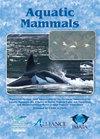墨西哥尤卡坦半岛瓶鼻海豚(Tursiops truncatus)皮肤中金属和类金属的测定
IF 0.8
4区 生物学
Q4 MARINE & FRESHWATER BIOLOGY
引用次数: 0
摘要
金属污染对海洋生态系统和海洋生物(包括鲸目动物)的健康构成重大威胁。本研究旨在使用火焰原子吸收光谱法(FAA)评估墨西哥尤卡坦半岛瓶鼻海豚(Tursiops truncatus)皮肤中某些金属和类金属的浓度。我们共收集了 41 份皮肤样本,其中 22 份来自墨西哥湾的尤卡坦半岛,19 份来自加勒比海的切图马尔湾。分析结果显示,尤卡坦半岛沿海水域的瓶鼻海豚皮肤中含有多种元素。在检测到的金属中,锌(Zn)、铁(Fe)和砷(As)的含量较高,其含量顺序为锌(Zn)>铁(Fe)>砷(As)>铜(Cu)>铬(Cr)>镉(Cd)>镍(Ni)。锌和铁的高浓度表明,所研究的海豚种群可能接触并积累了这些金属。有趣的是,在皮肤样本中没有检测到可测量的铅(Pb)和锰(Mn)浓度,这表明在所研究的海豚种群中,这两种金属的含量很低或没有积累。众所周知,铅会对海洋生物造成有害影响,而且通常与人类活动有关,因此没有检测到可测量的铅浓度尤其令人鼓舞。这项研究为了解墨西哥尤卡坦半岛瓶鼻海豚的金属污染状况提供了宝贵的信息。锌、铁和砷的显著浓度引起了人们对这些极具魅力的海洋哺乳动物潜在健康风险的担忧。有必要开展进一步研究,以调查该种群接触重金属的来源和途径,并了解这种接触对尤卡坦半岛瓶鼻海豚健康和福祉的潜在影响。本文章由计算机程序翻译,如有差异,请以英文原文为准。
Determination of Metal and Metalloids in Bottlenose Dolphins’ (Tursiops truncatus) Skin from the Yucatan Peninsula, Mexico
Contamination by metals poses a significant threat to marine ecosystems and the health of marine organisms, including cetaceans. This study aimed to assess the concentrations of some metal and metalloids in the skin of bottlenose dolphins (Tursiops truncatus) from the Yucatan Peninsula in Mexico using Flame Atomic Absorption (FAA) spectrometry. A total of 41 skin samples were collected, comprising 22 samples from Yucatán in the Gulf of Mexico and 19 samples from Chetumal Bay in the Caribbean. The results of our analysis revealed the presence of various elements in the skin of bottlenose dolphins from coastal waters in the Yucatan Peninsula. Among the detected metals, zinc (Zn), iron (Fe), and arsenic (As) exhibited notable concentrations, with the order of abundance being Zn > Fe > As > Cu > Cr > Cd > Ni. The elevated concentrations of Zn and Fe suggest potential exposure and accumulation of these metals in the studied dolphin population. Interestingly, measurable concentrations of lead (Pb) and manganese (Mn) were not detected in the skin samples, indicating either low levels or the absence of their accumulation in the studied dolphin populations. The absence of measurable Pb concentrations is particularly encouraging as Pb is known to have detrimental effects on marine organisms and is commonly associated with anthropogenic activities. This study provides valuable insights into the metal contamination status in bottlenose dolphins from the Yucatan Peninsula, Mexico. The notable concentrations of Zn, Fe, and As raise concerns about potential health risks to these charismatic marine mammals. Further research is warranted to investigate the sources and pathways of heavy metal exposure in this population and to understand the potential consequences of such exposure on the health and well-being of bottlenose dolphins in the Yucatan Peninsula.
求助全文
通过发布文献求助,成功后即可免费获取论文全文。
去求助
来源期刊

Aquatic Mammals
MARINE & FRESHWATER BIOLOGY-ZOOLOGY
CiteScore
1.60
自引率
16.70%
发文量
99
审稿时长
>12 weeks
期刊介绍:
Aquatic Mammals is a peer-reviewed journal sponsored by the European Association for Aquatic Mammals (EAAM), the Alliance of Marine Mammal Parks and Aquariums (AMMPA), and the International Marine Animal Trainers’ Association (IMATA). Aquatic Mammals publishes articles related to marine mammals (whales, dolphins, seals, fur seals, sea lions, walrus, dugongs, manatees, sea otters, and polar bears). Topics of publication on both captive animals and wild marine mammals include aspects of husbandry; behavior; conservation; veterinary medicine; anatomy; physiology; training; population trends; and the effects of pollution, climate change, and noise.
 求助内容:
求助内容: 应助结果提醒方式:
应助结果提醒方式:


